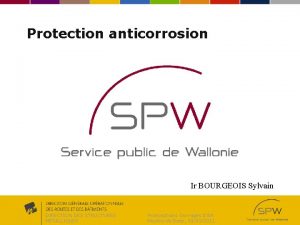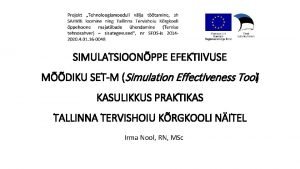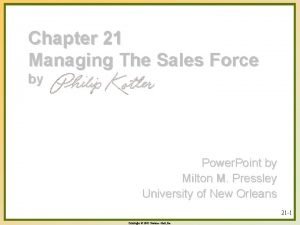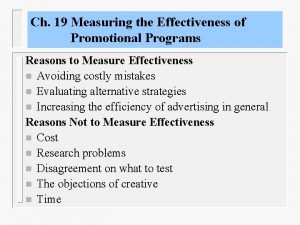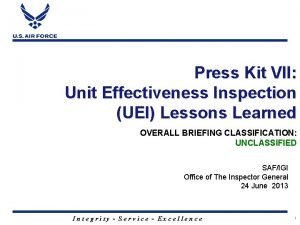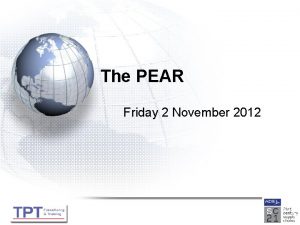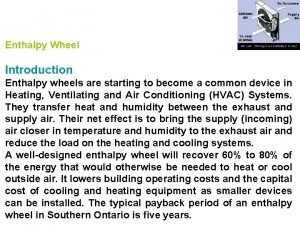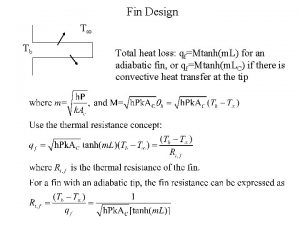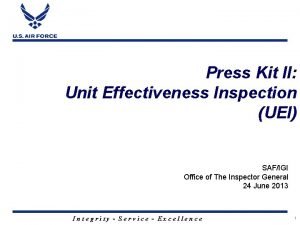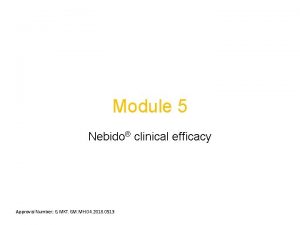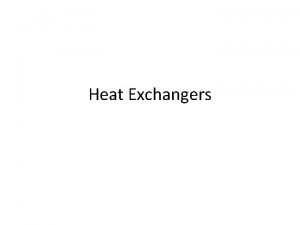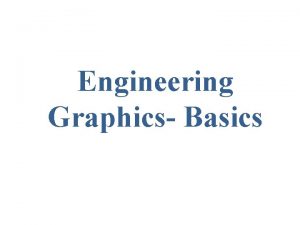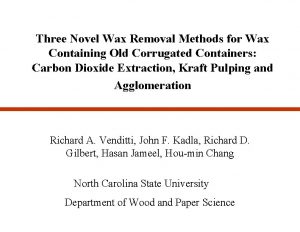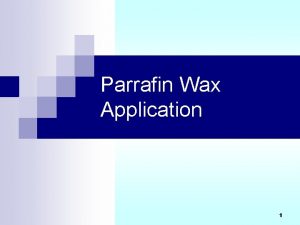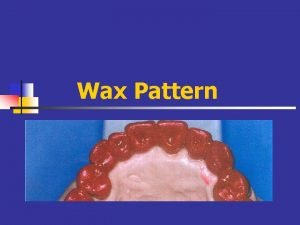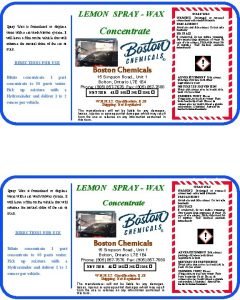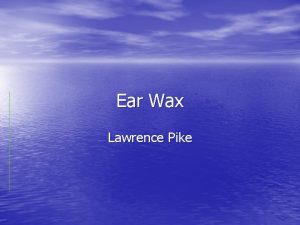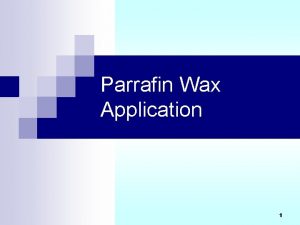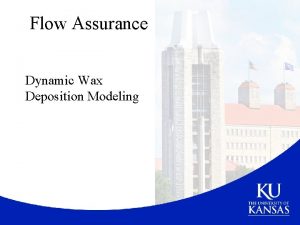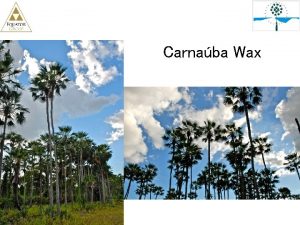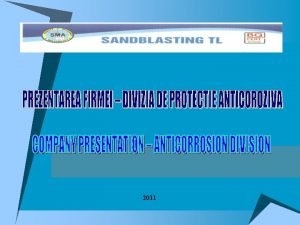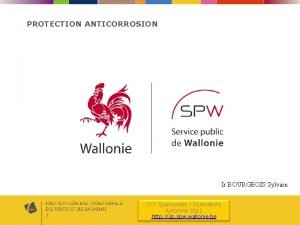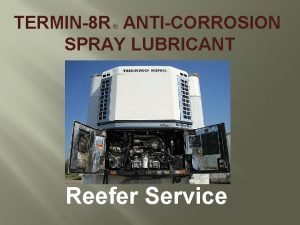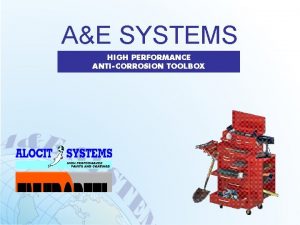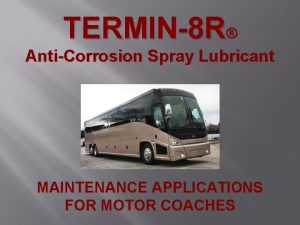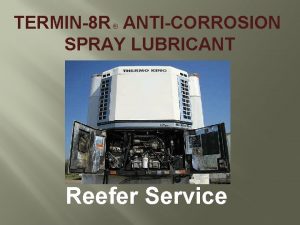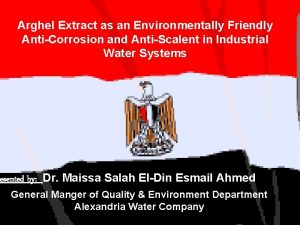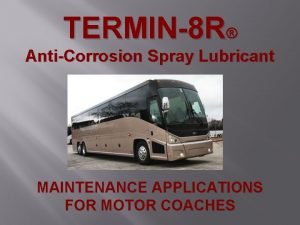Effectiveness of Wax as an Anticorrosion Material Frank






















































- Slides: 54

Effectiveness of Wax as an Anticorrosion Material Frank Rampton Trenton Corporation

Wax as an Anticorrision Coating § Types of Waxes § Characteristics & Effectiveness as a Coating Material § Applications § Tapes § Casing Filling § Hot-Applied Wax

What are the Characteristics of Wax? § Fun handouts are designed to make serious points § Malleable § Depending on temperature and composition § A solid at room temperature, but has a relatively low melting point § Does not crack as the pipe flexes § Seals with itself very well (not just adhere, actually seals) § Displaces moisture (chews forever) § If it can hold moisture, it can keep it from the pipe surface § Protects against the atmosphere § Used to protect food § Non-biodegradable § Non-toxic § Very user friendly

But Wax Does Not Look “Tough” § How can a material that is relatively soft and has a relatively low melting point make a good anticorrosion material? § Permeates the surface of the metal § When struck, it deforms and presses even more into the metal § “You can’t even sandblast wax off the surface. ”

The Five Major Types of Waxes Wax Types Vegetable 1. 75% Animal 0. 75% Synthetic 0. 25% Mineral 0. 25% Petroleum 97%

Vegetable Wax § Makes up 1. 75% of the total use. § Include carnauba & palm § Applications: chewing gum, polishes, inks & leathers

Animal Wax § Makes up 0. 75% of the wax usage § Includes beeswax, shellac § Applications: candles, polishes, cosmetics

Synthetic Wax § Makes up 0. 25% of the market § Applications: polishes, inks and coatings

Mineral Wax § Mineral wax (ozocerite) is the byproduct of ground petroleum (from sandstone) and coal § A brown to black wax sometimes found in sandstone and used to make candles, polishes, etc.

Petroleum Wax § Produced by de-oiling certain fractions from the petroleum refining process (97% of all waxes) § Almost ½ of this type is utilized in paper & packaging applications

Three Types of Petroleum Wax 97% Paraffin Petrolatum Wax Microcrystalline Wax § They can be blended § The wax of choice is based partially on results desired § Most pipe coatings use either petrolatum or microcrystalline wax (micro wax)

The Three Petroleum Waxes § Paraffin Wax § More brittle § Petrolatum Wax § Between paraffin and microcrystalline in characteristics § Microcrystalline Wax (Micro Wax) § § § Name is due to a finer crystalline structure Softer yet tougher, does not crack or flake More malleable and flexible Higher melting point More adhesive, sticks to the surface better Finer crystal structure better binds to solvents or oils and thus prevents the sweating-out of compositions

Why Micro Wax is a Good Coating § Long history of use: It has been used as an anticorrosive material for over 50 years. § Extremely low moisture absorption and transmission rates: Waxes are solidified oils, and like oil they do not absorb or transmit moisture. § Superior surface wetting: It “wets” the surface, like grease or oil, and will not be displaced by moisture § Permanent flexibility: Micro wax does not become brittle or lose its plasticity and flexibility. It will not flake off or crack after being applied, and it accommodates pipe expansion, contraction and flexing.

Why Micro Wax is a Good Coating (cont. ) § Superior adhesion: Micro wax permeates the granular structure of the steel, so it withstands soil stress and separates moisture from the pipe surface. § Resilience under impact: Though micro wax will deform under impact, it will not break, crack or “powder, ” and usually a thin film of tightly bonded, very corrosionresistant material will continue to protect the pipe. § Totally inert: Micro wax does not degrade, so it is extraordinarily long lasting. § Relatively inexpensive: Especially when total application costs are considered.

Petrolatum and Micro Wax-Based Tapes Petrolatum and micro wax-based tapes are used in aboveground and belowground applications.

Conforms to Irregular-Shaped Fittings Tape is molded into place to conform to the shape of the surface being wrapped.

Belowground Fittings Wax-based tapes are excellent protection for irregular-shaped valves.

Belowground Fittings

Weld Joint: Unprotected

Weld Joint: Primer and Tape Applied

Weld Joint: Outerwrap Applied

Underground Pipe This wax-based tape application has a moisture-cured outerwrap.

Aboveground Pipe This photo shows a Gulf Coast micro wax-based tape application after 14 years.

Mile-Long Application over New Pipe

Well Head

Vaults/Pits/Chamber Application

Risers A gas company had troubles with FBE coating on risers and used wax-based tape over the FBE coating. Photo on right shows results after seven years.

Bridge Span Pipe Micro wax-based tape protected this Ohio bridge span pipe for 18 years.

Bridge Span Pipe

Tank Chime Protection

Cooling Tower Piping

Benefits of Wax-Based Tapes § Aboveground and Belowground Benefits: § Easy to apply by unskilled workers § Better application at lower cost § § § Safe to use, non-toxic Minimal surface preparation Chemically inert Long lasting May be applied on a wet surface Conformable to irregular surfaces

Benefits: Belowground and Aboveground § Belowground Benefits: § § Resistant to cathodic disbondment Good dielectric strength § Aboveground Benefits: § UV stable providing years of service § Diverse application environments § “In the northern climates during winter, it’s one of the few products that works. ” § Some tapes can be painted after 2 weeks if desired (acrylic latex paint is preferred) § Can be applied over old paint systems if necessary § Can be applied on a sweating pipe

Casing Filling

Casing Filling Process

Benefits of Wax Casing Filling § § § § § Anti-corrosive Water resistant, so it will not absorb or mix with water Dielectric (electrically non-conductive) Inert, so it does not degrade or dissolve over time Non-hazardous, both as to the environment (non-toxic) and handling (non-flammable) Pliable, resistant to cracking Remains firm at temperatures at which the facility normally operates (if it were to liquefy, it could leak into the soil through the end seals) Relatively inexpensive Easy to install

Hot-Applied Micro Wax

Hot-Applied Micro Wax: Application § Applied in a “flood coat” manner by heating it and pouring it onto the pipe § Overwrapped with protective outerwrap § Final flood coat on top of outerwrap

Hot-Applied Wax

Hot-Applied Wax: Product Features § Used on new pipe or to patch partially or completely deteriorated pipeline coatings in the ditch § No sandblasting required, just SSPC SP-2 surface prep § Non-toxic and no smoke or poisonous fumes § Long lasting, has history of 50 years in North America § Reduced application costs § Saving time & money § Accommodates pipe expansion, contraction and flexing § Unused product can be reheated and used again (unlimited shelf life) § Diverse application environments (used over wide temperature ranges)

Application Procedure Wax is heated to 250 to 350 degrees F in a kettle or dope pot.

Hot-Applied Wax Outerwrap

Hot Wax & Outerwrap Applied

Reconditioning a Coal Tar Coated Pipe

Girth Weld Application: Unprotected

Hot Wax is Poured over the Weld

2 nd Coat of Hot Wax over the Outerwrap

Hot-Applied Wax: Followup After 10 years in service, pipe and wax are still in excellent condition.

Hot-Applied Wax: Followup After 50 years with hot wax, pipe showed virtually no corrosion. Wax literally could have been re-melted and reused.

Hot-Applied Micro Wax for Pipes § Benefits: § Low moisture absorption & transmission rates (resists moisture) § Good surface wetting § Permanent flexibility § Excellent adhesion § Chemically inert § Resilience under impact § Cost effective (unused wax can be reheated)

Wax Coatings Technical Recognition § NACE RP 0375 -06 Wax Coating Systems for Underground Piping Systems § AWWA C 217 -09 § Wax coatings are approved in numerous oil and gas pipeline coatings manuals and in various international standards

Summary on All Wax Coatings: § § § Effective in mitigating corrosion Easy on the workers and the environment Low surface prep Ease of application improves reliability of application Low total cost of application Long lasting, successfully used for over 60 years

Questions?

 En iso 12944 3
En iso 12944 3 Frank william abagnale jr. frank abagnale, sr.
Frank william abagnale jr. frank abagnale, sr. Non material culture examples
Non material culture examples What is real culture
What is real culture Gd and t symbol
Gd and t symbol Non material culture examples
Non material culture examples Material price variance formula
Material price variance formula Useful and harmful example
Useful and harmful example Nc educator effectiveness system
Nc educator effectiveness system Enhancing personal effectiveness
Enhancing personal effectiveness Managerial behavior and effectiveness
Managerial behavior and effectiveness Debriifing
Debriifing Measuring coaching effectiveness
Measuring coaching effectiveness Definition of personal resources
Definition of personal resources Materiality constraint
Materiality constraint Cope certificate
Cope certificate Liberal reforms essay
Liberal reforms essay Effectiveness of nurse residency programs
Effectiveness of nurse residency programs Importance of curriculum development
Importance of curriculum development Sales force effectiveness ppt
Sales force effectiveness ppt Personal effectiveness framework
Personal effectiveness framework Efficiency and effectiveness in higher education
Efficiency and effectiveness in higher education Evaluate the effectiveness of social control inside prisons
Evaluate the effectiveness of social control inside prisons Measuring the effectiveness of the promotional program
Measuring the effectiveness of the promotional program Measuring workforce effectiveness
Measuring workforce effectiveness Slip slop slap campaign effectiveness
Slip slop slap campaign effectiveness Air force uei
Air force uei Loss of effectiveness
Loss of effectiveness Principles of effectiveness
Principles of effectiveness Ntu in heat exchanger
Ntu in heat exchanger Ppg examples for educator effectiveness
Ppg examples for educator effectiveness As9100 pear examples
As9100 pear examples Efficiency and effectiveness examples
Efficiency and effectiveness examples Site:slidetodoc.com
Site:slidetodoc.com Steiner's model of group effectiveness
Steiner's model of group effectiveness Enthalpy wheel effectiveness
Enthalpy wheel effectiveness Advancing education effectiveness
Advancing education effectiveness Effectiveness algoritma
Effectiveness algoritma The effectiveness of online and blended learning
The effectiveness of online and blended learning Total fin
Total fin Robbins team effectiveness model
Robbins team effectiveness model Uei air force
Uei air force Artificial intelligence sop
Artificial intelligence sop Pear process effectiveness assessment report
Pear process effectiveness assessment report Nebido effectiveness
Nebido effectiveness Effective and efficient example
Effective and efficient example Sales performance management framework
Sales performance management framework Goals of interpersonal effectiveness
Goals of interpersonal effectiveness Cmin heat exchanger
Cmin heat exchanger Relative effectiveness
Relative effectiveness Stronge leader effectiveness performance evaluation model
Stronge leader effectiveness performance evaluation model What is graphic language in engineering drawing
What is graphic language in engineering drawing Steiner's model of actual productivity
Steiner's model of actual productivity Look for me
Look for me Managing productivity and marketing effectiveness
Managing productivity and marketing effectiveness
